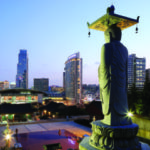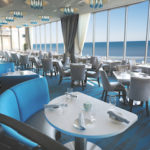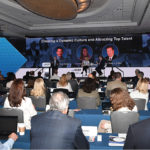
I experienced the city’s walkable charm for myself — along with many of the reasons why Munich frequently lands on Top 10 lists of the world’s most livable cities — when I stopped over on my way to the 64th Lindau Nobel Laureate Meeting. Now the capital of the Bavarian state, Munich was the royal seat of the Bavarian dukes beginning in the 13th century. Downtown is still centered around centuries-old streets and buildings, including a sprawling palace complex and the always-bustling central square, the Marienplatz, where the “new” town hall was built between 1867 and 1908.
I stayed in the 350-room Bayerischer Hof in the city center — the name is translated, aptly, as “Bavarian Palace” in English. The luxurious hotel was built in 1841, and incorporated a neighboring palace that was built in 1813 into the property in 1969. The hotel has five restaurants, including the rooftop Blue Spa Bar and Lounge, which serves spa cuisine and offers a prime perch from which to look out over the city’s many church spires and red-tiled roofs. Bayerischer Hof also has 40 meeting rooms, including a two-story ballroom with a retractable glass roof, and a theater, with the capacity to accommodate groups of 2,000 people. Every February, the hotel is the site of the three-day Munich Security Conference, which brings together heads of state, scientists, and others from more than 70 countries to focus on global security.
Ranked as Germany’s safest big city, Munich is easy to navigate. The day I arrived, I wandered along its streets with no other goal in mind than to get a feel for the place.
One happy discovery was the Viktualienmarkt, an open-air food market established in 1807, which was filled with the leisurely sociability of families and friends eating, laughing, and drinking in the late-afternoon sunshine. The market’s wooden stands, offering everything from pastries, chocolates, fresh flowers, and produce to every kind of German sausage imaginable, are built around a small public beer garden. Beer gardens are a Bavarian institution — there’s even a beer garden at the Munich Airport — dating back two centuries when the city’s beer brewers began to dig beer cellars underground, planting chestnut trees over- head so that their shade would keep the beer cool through the summer.
On my second day in the city, the Munich Convention Bureau supplied me with a guide, Andreas Zürner, who oriented me, on foot and by car, on the city’s attractions for meeting attendees. (Munich may have the friendly appeal of a big village, but it also offers 34,200 hotel rooms and more than 500 meeting venues.)
We first ducked into the fantastically ornate Asamkirche, an 18th-century Baroque- and Rococo-style church, where Zürner gave me a crash course in how the Catholic Church used flowery architecture and theater to engage the population and influence the region.
“Bavaria,” Zürner said as we took a walk around the city’s Old Town, “is a festival for the emotions and the senses.”
Also on our itinerary was Hofbräuhaus, Munich’s biggest and most famous beer hall, where tourists and locals alike can be found in droves. The beer hall is operated by the Bavarian government — it was founded in 1589 as the royal brewery — and is topped by Festival Hall, which seats 900. We also stopped by the Lowenbraukeller, another of the city’s most popular beer gardens. We toured its rooftop terrace, overlooking central Munich, and its own Festival Hall, which can accommodate up to 2,000 people.
In particular, the city has a long tradition as a center of engineering excellence — BMW is headquartered in Munich — as well as the more recent but thriving biotechnology and pharmaceutical industries, supported by world-class academic and medical institutions.
We stopped by the Deutsches Museum, the world’s largest museum of technology and engineering, which was founded in 1903 by the German Society of Engineers and built on an island in the Isar River. Its more than 50 exhibit halls cover everything from early ship- building to space travel, with exhibits devoted to natural sciences, materials production, energy, communications, pharmaceuticals, and dozens more topics. To a non-scientist like me, the museum’s exhibits were fascinatingly accessible, and many of the professionals attending scientific meetings in Munich likewise find the museum completely absorbing, Zürner told me.
Another popular off-site venue for tech-minded meeting attendees is the BMW Welt (Welt translates to “world” in English), a BMW museum, with both historic and contemporary versions of the company’s automobiles and motorcycles, including rare Rolls- Royce models. The futuristic, metallic lines of BMW World’s architecture are as sleek as those of the company’s cars, and the BMW Event Forum offers facilities including an auditorium that can accommodate groups of up to 800, meeting rooms, a restaurant, and an outdoor terrace.



